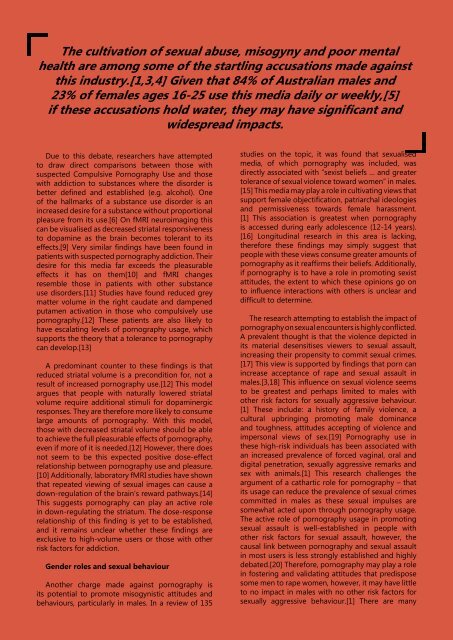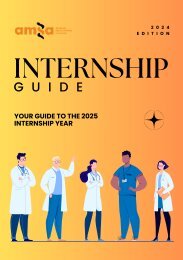Vector Volume 12 Issue 2 - 2018
You also want an ePaper? Increase the reach of your titles
YUMPU automatically turns print PDFs into web optimized ePapers that Google loves.
The cultivation of sexual abuse, misogyny and poor mental<br />
health are among some of the startling accusations made against<br />
this industry.[1,3,4] Given that 84% of Australian males and<br />
23% of females ages 16-25 use this media daily or weekly,[5]<br />
if these accusations hold water, they may have significant and<br />
widespread impacts.<br />
Due to this debate, researchers have attempted<br />
to draw direct comparisons between those with<br />
suspected Compulsive Pornography Use and those<br />
with addiction to substances where the disorder is<br />
better defined and established (e.g. alcohol). One<br />
of the hallmarks of a substance use disorder is an<br />
increased desire for a substance without proportional<br />
pleasure from its use.[6] On fMRI neuroimaging this<br />
can be visualised as decreased striatal responsiveness<br />
to dopamine as the brain becomes tolerant to its<br />
effects.[9] Very similar findings have been found in<br />
patients with suspected pornography addiction. Their<br />
desire for this media far exceeds the pleasurable<br />
effects it has on them[10] and fMRI changes<br />
resemble those in patients with other substance<br />
use disorders.[11] Studies have found reduced grey<br />
matter volume in the right caudate and dampened<br />
putamen activation in those who compulsively use<br />
pornography.[<strong>12</strong>] These patients are also likely to<br />
have escalating levels of pornography usage, which<br />
supports the theory that a tolerance to pornography<br />
can develop.[13]<br />
A predominant counter to these findings is that<br />
reduced striatal volume is a precondition for, not a<br />
result of increased pornography use.[<strong>12</strong>] This model<br />
argues that people with naturally lowered striatal<br />
volume require additional stimuli for dopaminergic<br />
responses. They are therefore more likely to consume<br />
large amounts of pornography. With this model,<br />
those with decreased striatal volume should be able<br />
to achieve the full pleasurable effects of pornography,<br />
even if more of it is needed.[<strong>12</strong>] However, there does<br />
not seem to be this expected positive dose-effect<br />
relationship between pornography use and pleasure.<br />
[10] Additionally, laboratory fMRI studies have shown<br />
that repeated viewing of sexual images can cause a<br />
down-regulation of the brain’s reward pathways.[14]<br />
This suggests pornography can play an active role<br />
in down-regulating the striatum. The dose-response<br />
relationship of this finding is yet to be established,<br />
and it remains unclear whether these findings are<br />
exclusive to high-volume users or those with other<br />
risk factors for addiction.<br />
Gender roles and sexual behaviour<br />
Another charge made against pornography is<br />
its potential to promote misogynistic attitudes and<br />
behaviours, particularly in males. In a review of 135<br />
studies on the topic, it was found that sexualised<br />
media, of which pornography was included, was<br />
directly associated with “sexist beliefs … and greater<br />
tolerance of sexual violence toward women” in males.<br />
[15] This media may play a role in cultivating views that<br />
support female objectification, patriarchal ideologies<br />
and permissiveness towards female harassment.<br />
[1] This association is greatest when pornography<br />
is accessed during early adolescence (<strong>12</strong>-14 years).<br />
[16] Longitudinal research in this area is lacking,<br />
therefore these findings may simply suggest that<br />
people with these views consume greater amounts of<br />
pornography as it reaffirms their beliefs. Additionally,<br />
if pornography is to have a role in promoting sexist<br />
attitudes, the extent to which these opinions go on<br />
to influence interactions with others is unclear and<br />
difficult to determine.<br />
The research attempting to establish the impact of<br />
pornography on sexual encounters is highly conflicted.<br />
A prevalent thought is that the violence depicted in<br />
its material desensitises viewers to sexual assault,<br />
increasing their propensity to commit sexual crimes.<br />
[17] This view is supported by findings that porn can<br />
increase acceptance of rape and sexual assault in<br />
males.[3,18] This influence on sexual violence seems<br />
to be greatest and perhaps limited to males with<br />
other risk factors for sexually aggressive behaviour.<br />
[1] These include: a history of family violence, a<br />
cultural upbringing promoting male dominance<br />
and toughness, attitudes accepting of violence and<br />
impersonal views of sex.[19] Pornography use in<br />
these high-risk individuals has been associated with<br />
an increased prevalence of forced vaginal, oral and<br />
digital penetration, sexually aggressive remarks and<br />
sex with animals.[1] This research challenges the<br />
argument of a cathartic role for pornography – that<br />
its usage can reduce the prevalence of sexual crimes<br />
committed in males as these sexual impulses are<br />
somewhat acted upon through pornography usage.<br />
The active role of pornography usage in promoting<br />
sexual assault is well-established in people with<br />
other risk factors for sexual assault, however, the<br />
causal link between pornography and sexual assault<br />
in most users is less strongly established and highly<br />
debated.[20] Therefore, pornography may play a role<br />
in fostering and validating attitudes that predispose<br />
some men to rape women, however, it may have little<br />
to no impact in males with no other risk factors for<br />
sexually aggressive behaviour.[1] There are many<br />
15

















